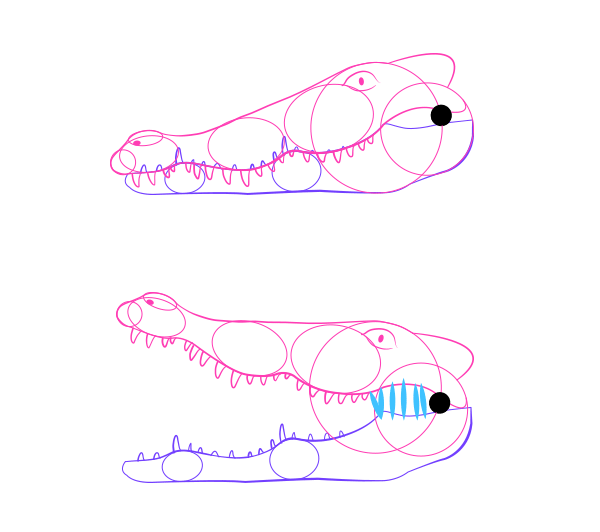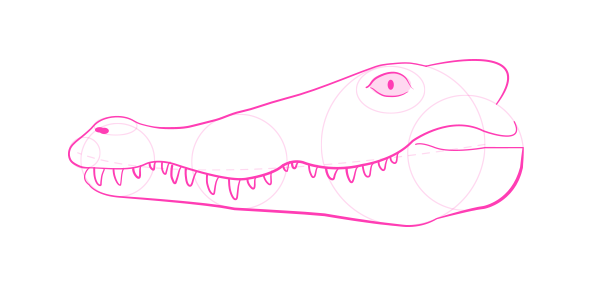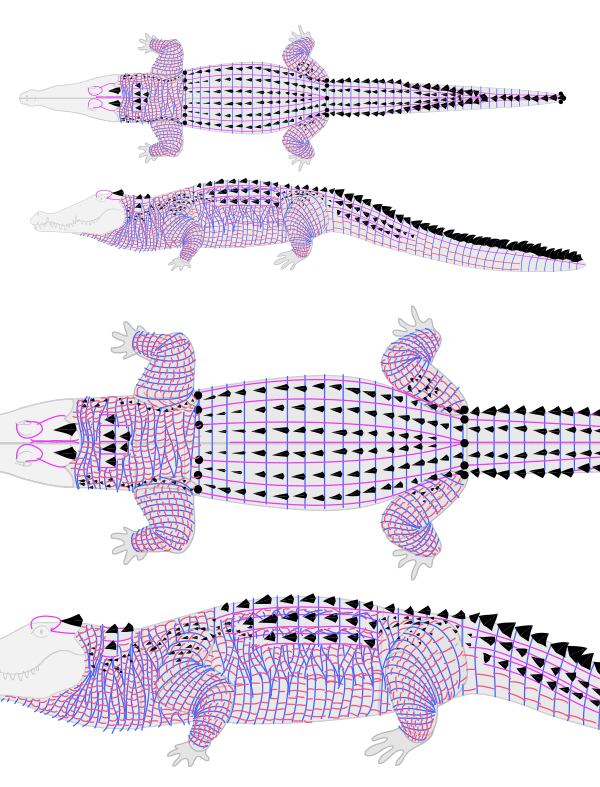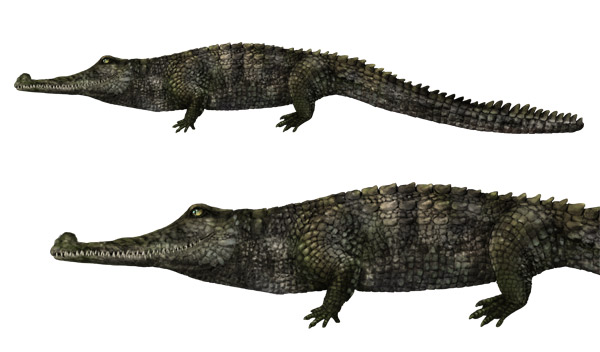
Although crocodiles aren't the closest extant relatives of dinosaurs, they surely don't look much different than them. Big, scaly, ferocious, with huge jaws full of sharp teeth—they make a good reference for dragons, don't they? Let's take a look at four species of crocodilians (the family of crocodiles): the well known crocodiles and alligators, and lesser known species such as caimans and gharials.
1. General Crocodile Anatomy
Skeleton
Let's take a look inside a crocodile to understand what makes its body look as it does.
First of all, notice how huge the skull is in comparison to the rest of the body. It's quite uncommon for modern vertebrates! Also, the body is very long and kept very close to the ground because of the short limbs and sprawling gait. The tail is long, very big, and makes up a significant part of the body.

All these bones would be hard to remember, but we don't need to do it. We can simplify the most important pieces of information into something much more useful:

To create the correct pose of an animal we need to know how it moves. As you may have noticed, crocodiles often "crawl" with their belly almost on the ground. It's because of their "sprawling" posture—their elbows and knees are pointing to the outside (B) instead of being kept on the sides of the body (A). However, unlike lizards, crocodiles aren't restricted to this movement; they can stand almost upright, with their limbs rotated the "correct" way. This lets them move very fast.
Another important thing to remember is that crocodiles drag their tails on the ground, which differentiates them from dinosaurs.


Body
The crocodile's musculature is hidden well under the thick skin, so we don't need to learn about individual muscles. Let's just take a look at how invisible muscles define the visible silhouette:


2. Draw the Head of a Crocodile
Step 1
Start with a gentle curve. Attach a big circle to it, then another one in the middle, and one on the end.
Add a smaller circle to the last one (the tip of the "lips") and an ellipse on the top (the nose). Attach a circle to the biggest one—it will be the back of the lower jaw.

Step 2
Use the circles and the spaces between them to determine the curve of the crocodile smile.

Step 3
Add eyes on the top of the head.

Step 4
Base your final lines on the guide lines.

Step 5
Time for the teeth! Crocodiles have both their jaws the same width, so all the teeth will be visible. Can you see the curves of the "lips"? The longest teeth are where the curve is the the most convex.

Step 6
Draw the upper teeth according to this formula.

Step 7
Now, for the lower teeth—locate the convex parts...

Step 8
... and draw the teeth.

Step 9
Use the same circles to create the top view. Make sure to keep them in a row!

Step 10
Add the eyes on the top...

Step 11
... and the rest should be quite simple. Notice the V-shape!

Step 12
What's really interesting about the crocodile head is that what you see is actually a skull covered with skin—there are very few muscles in this area. There's just one great exception: the jaw muscles. Observe how they work to draw the opened mouth of a crocodile properly:

Step 13
Alligators are very similar to crocodiles, but there are two things that make it easy to distinguish them. First, the lower jaw of the alligator is narrower than the upper one, so the lower row of teeth isn't visible on the top.

Second, the head of the alligator is much wider, U-shaped, and less curvy.

Step 14
Caimans, smaller relatives of true crocodiles, look just like smaller crocodiles—the snout is shorter, and the eyes seem bigger and more protruding.

Step 15
Another member of the crocodile family, the gharial, has a really characteristic head:
- very long snout with a distinctive bump on the end (males only)
- even rows of teeth
- protruding eyes

3. Draw the Eyes of a Crocodile
Step 1
Start with an ellipse and draw the pupil inside. Just like cats, crocodiles' eyes are slit in the light and round in the dark.

Step 2
Add the ridges around.

Step 3
Add simple lines to create scales.

Step 4
Crocodile eyes are protruding, so that the animal can keep them above the water level when its body is fully submerged. Remember that when drawing the eye—it shouldn't be "stuck" to a flat wall of skull, but should have a 3D structure.

Step 5
There's an ear right behind the eye, so let's include it.

Step 6
Add the scales.

Step 7
And finish it up.

4. Draw the Feet of a Crocodile
Crocodiles have five toes on the front feet and four toes on the hind feet. The webbing depends on the actual species:
- Alligators have all their feet webbed.
- Caimans and gharials have their back feet webbed.
- True crocodiles may have their back feet webbed, or none at all, depending on the species.

Step 1
To draw the feet, start with a general construction. The ellipse defines the point of "pushing".

Step 2
Add the toes.

Step 3
Add circles almost on the tip, to define the width of the toes.

Step 4
Draw the outlines of the toes. Notice that this outline is pretty simple to draw even without any type of guide lines ("baby hands"), so you may skip the previous steps and go right here, if you feel confident.

Step 5
Add the claws. Notice that not all of the toes end with claws! (Use the scheme from before as a reference).

Step 6
Now, if your species has the webbing, add it.

Step 7
Polish up the drawing.

5. Draw the Crocodile Scales Pattern
Although the skin of a crocodile may look very complicated, it's actually friendlier for drawing than a snake or a fish. Let's see how to turn this chaos into order!
Step 1
Start with vertical bands around the body.

Step 2
Cross them with horizontal lines just as below. The first of the squarish scales should appear.

Step 3
The scales we've just sketched are the keeled ones—they have a ridge, or a small plate, in the middle.

Step 4
Now, add horizontal lines on the rest of the squarish, but un-keeled scales. They don't need to be very even; it's even better if they are a little bit random.

Step 5
The areas that are left are where all the chaos begins. Very small, roundish scales occur here in irregular rows. Create these rows:

Step 6
Then cut these rows with short horizontal lines.

Step 7
Some of the smaller scales are slightly keeled too, although with them it looks more like a hump. These scales will seem bigger and thicker among the others.

Step 8
Place two big keeled scales behind the eyes, and two plates on top of them.

Step 9
When it comes to the head, it's not actually covered in scales—it's rather cracked skin, so it has the same pattern as dried mud.

Step 10
If you follow all the guide lines, you should have now a fully scaled crocodile. It's surely a lot of work! In the practical part of this tutorial I'll show you how to avoid this chore at least partially.

6. Meet the Crocodile Species
We've already mentioned some of the crocodiles, so let's get to know them more closely. Remember—colors may vary depending on the actual species.
The Crocodile
"True crocodiles" belong to the largest of the family. They're usually olive-green, with darker patches that may create stripes. The underside is brighter, yellowish or creamy white.

The Alligator
As I've already said, alligators have wider snouts, with only the upper row of teeth showing when the mouth is closed. Their head is also smoother. They are darker than crocodiles, with a more whitish underside.

The Caiman
Caimans, such as the spectacled caiman, look like smaller crocodiles with big heads. To stress the difference between them and their bigger cousins, you can use brown as their main color.

The Gharial (Gavial)
Gharials are the easiest to picture properly—their snouts are impossible to confuse with any other crocodilian. When it comes to colors, they can be black, dark brown, and even vivid green.

7. Practical Exercise—Draw a Crocodile Step By Step
Now we're going to take all this dry information and use it for something practical. Remember: I'm only showing you how to use it, so don't copy me step by step—rather, do the same as me, using the tips from previous steps in your own way.
Step 1
Start by sketching the idea right from your mind. You should include the simplified skeleton in this, but it doesn't need to be visible.

Step 2
Define the body blocks. If you're having problems here, remember—it's not about drawing crocodiles now. It means you should work on your manual skills and/orperspective before trying something as specific as animals.

Step 3
Sketch the head according to the instruction.

Step 4
Draw the outlines of the head.

Step 5
Add the teeth.

Step 6
Connect the head with the rest of the body by adding the neck. Bigger crocodiles and alligators have a "flagging" neck that gets flattened like a big bag of sand when the animal is on the ground.

Step 7
Now we're going to work on the scales. I promised to show you a non-chore way of drawing them, so let's see what we can do. Start by defining the basic lighting. It's light that sculpts details, so we don't need to draw them in the shadows.

Step 8
Draw the guide lines for scales, step by step, only in the light area and on its borders.









Step 9
Then draw the scales: solid in the light area and subtler in the transition area.

Step 10
If it's only a sketch, you can also add simple grids in the shadow looking like simplified scales.

Step 11
Finish the picture any way you want!

We're Done!
Now you can draw your own ferocious crocodiles! Feel free to use this information to create your own species, including dragons and other fantastic beasts. If you like this tutorial, make sure to check others of the series. Thank you for spending some time with me and see you next time!



.webp)

